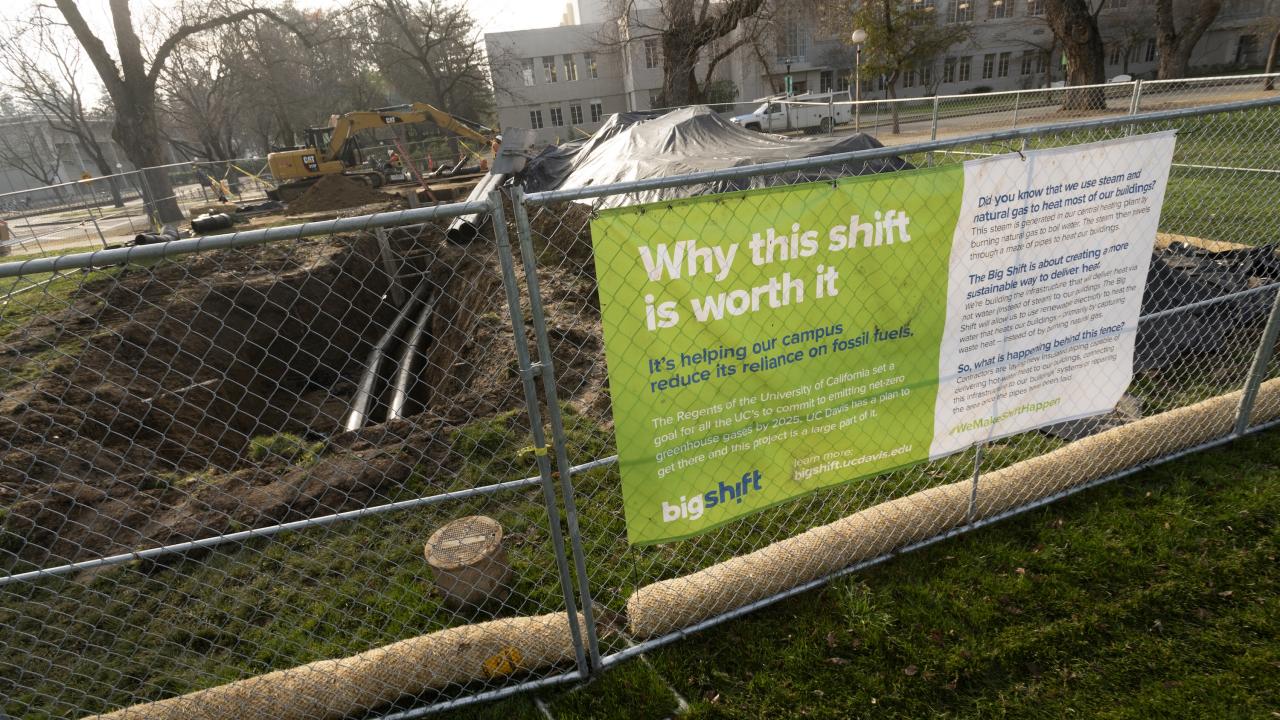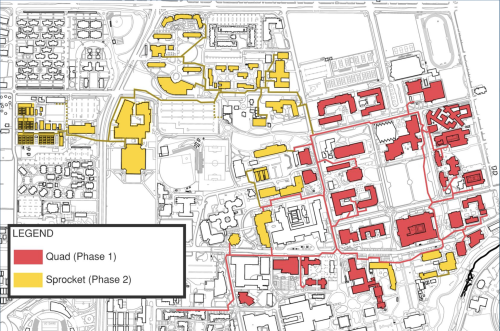Campus commits $55.5 million to the next phase of Big Shift
Earlier this month, the Chancellor and the Chancellor’s Committee on Campus Planning and Design, or CCCPD, endorsed moving forward with a $55.5 million investment of campus funds for the next phase of the Big Shift – a heating infrastructure overhaul that represents a crucial step in reducing the university’s fossil fuel usage.

Big Shift is a big deal
The Big Shift is a multi-year, multi-phase, campus-spanning infrastructure project converting the central heating system on the Davis campus from steam based to hot water based. Producing steam is accomplished by the combustion of natural gas — a fossil fuel. By shifting to a hot water system — one that does not require boiling temperatures — the university will be able to use electricity as its primary energy source to heat the campus.
“The conversion of the campus heating system is a crucial step towards reducing UC Davis’ overall carbon footprint and eliminating our reliance on fossil fuels,” said Carla Fresquez, interim director of UC Davis Sustainability. “This infrastructure overhaul reflects how UC Davis is prioritizing long-term solutions that are high impact rather than quicker fixes that are lower impact.”
This massive change requires installing new hot water pipes underground, crisscrossing the campus, connecting each building that is currently on the steam system, and updating the equipment within each building to utilize the hot water. In order to execute the Big Shift, which spans dozens of miles of new pipe and hundreds of buildings, the project is broken up into phases that focus on converting different areas on campus. Completing all remaining phases is estimated to cost 250 million dollars.
So far — thanks to the first 55 million dollar investment by campus in 2019 — the Big Shift team has completed the first phase of the project, converting the largest district planned, the “Quad district,” which included buildings like the Memorial Union, the Silo, Shields Library and classroom buildings like Olson Hall, Wellman Hall, and the Social Sciences and Humanities building. Read more about the completion of the first district.
“For seven years running, UC Davis has been ranked the most sustainable University in North America. Our investments in projects such as the Big Shift define us as a leader,” said Clare Shinnerl, vice chancellor of Finance, Operations and Administration. “While we have several complex and critical phases to complete before full impact can be realized, I’m pleased that reducing fossil fuels at UC Davis continues to be Chancellor May’s priority.”
Sprocket on the docket

The 55.5 million dollars of campus funds will be used to update the infrastructure of 22 more buildings and lay 2.3 more miles of pipe to convert the “Sprocket district.”
The map shows the hot water pipelines that will be installed and the buildings that will be converted in the next phase of the Big Shift (Sprocket in yellow) along with the buildings and pipes encompassed in the first phase completed earlier this year (Quad in red). Take a closer look in the Big Shift interactive map.
“We are grateful for the campus's support and ongoing commitment to the Big Shift project. This recent multimillion-dollar investment was significant and certainly not easy to secure, given the numerous competing needs on campus,” said Dan Golde, director of engineering projects. “We've been able to maintain forward progress on Big Shift as Phase 1 closed out, and with this recent approval, we will continue to carry the experience and knowledge into the final design and construction of the Sprocket district.”
The Sprocket district includes the Segundo and Regan residence halls, the Student Health and Wellness Center, the ARC, and the University Credit Union Center, in addition to a handful of classroom and lab buildings. After the conversion of this district is complete, the Central Heating and Cooling Plant, or CHCP, will see a cumulative 10 percent reduction of natural gas usage.
“The natural gas savings in phases one and two are mainly due to reduced heat loss in the new hot water piping versus the old steam piping,” said Joshua Morejohn, executive director of Utilities and Engineering Operations at UC Davis Facilities Management.
Shifting to the future
While the conversion of each area on campus will result in additional fossil fuel savings, the university will still need to use natural gas to produce steam to heat buildings that have not been converted. The Big Shift team hopes to move seamlessly from one district to the next, reducing natural gas with each phase, with the help of outside funding.
“As the federal government, California, and energy providers increase their support for decarbonization projects, we are pursuing opportunities with them for grant funding sources that will supplement funds committed by the university,” Golde said.
To this end, FOA hired a grant writer to help pursue these funding options.
“We are optimistic that the Big Shift will benefit from some outside financial support as we advance through the remaining phases, enabling the campus to complete the Big Shift sooner rather than later,” Golde said.
The Big Shift team is especially eager to secure funding for updating the Thermal Energy Storage, or TES, Plant which will have a high impact, immediately reducing natural gas consumption at the CHCP by an additional 29 percent. Currently, hot water for buildings that have already been converted through the Big Shift is being produced using steam. Updates to the current TES Plant — including installing a hot water TES tank and replacing the two oldest chillers with heat recovery chillers — will provide a new energy efficient source of hot water that is not reliant on fossil fuels.